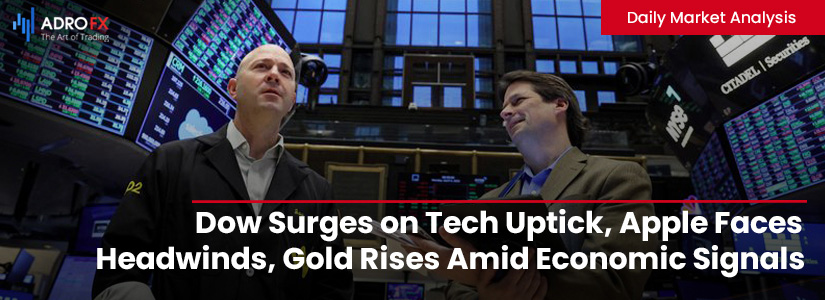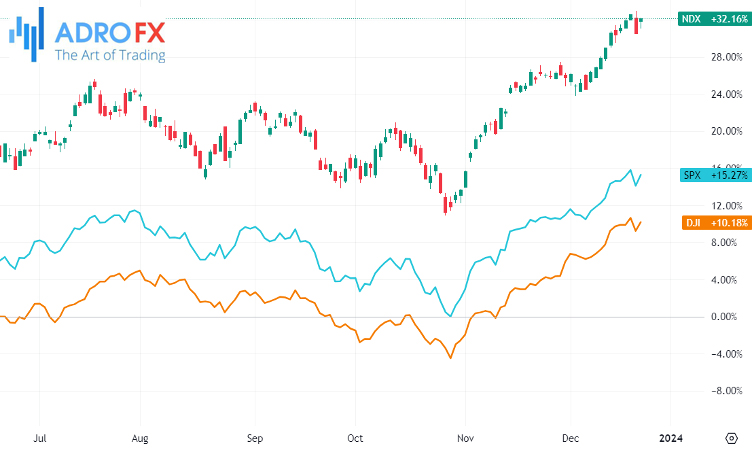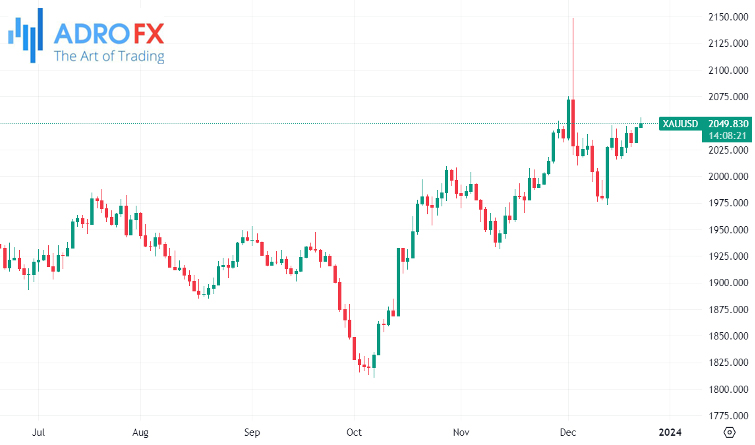Dow Surges on Tech Uptick, Apple Faces Headwinds, Gold Rises Amid Economic Signals, and Global Markets Show Mixed Results | Daily Market Analysis

Key events:
- UK - GDP (YoY) (Q3)
- UK - GDP (QoQ) (Q3)
- USA - Building Permits
- USA - Core Durable Goods Orders (MoM) (Nov)
- USA - Core PCE Price Index (MoM) (Nov)
- USA - Core PCE Price Index (YoY) (Nov)
- USA - New Home Sales (Nov)
On Thursday, the Dow experienced an upward surge as investors seized the opportunity to buy stocks following the previous day's sell-off. The market was buoyed by a notable uptick in tech stocks, led by Micron's robust quarterly results.
The Dow Jones Industrial Average marked a gain of 322 points, equivalent to a 0.9% increase. The S&P 500 also rose by 1%, and the NASDAQ Composite saw a notable climb of 1.3%.

However, Apple Inc (NASDAQ: AAPL) witnessed a reversal of gains after removing models, including the Series 9 and Ultra 2, of its Apple Watch from its website. This move was attributed to an ongoing patent dispute with Masimo concerning the blood oxygen feature on the watches.
Earlier this week, Apple announced proactive steps to comply with a ruling from The International Trade Commission, which found that certain versions of its Apple Watch infringed on two patents held by Masimo. President Joe Biden has until December 25 to potentially veto the ITC ruling.

In other Apple-related news, reports suggest that the tech giant is intensifying production of its Vision Pro mixed reality headset, anticipated for launch in February.
Gold prices advanced on Friday, building on gains from the previous session, as a slight downgrade to third-quarter US GDP and softer labor market data led to the dollar hitting four-month lows. The dollar's decline on Thursday contributed to the upward momentum in gold prices.
A revised reading on third-quarter GDP revealed slightly lower growth than initially anticipated, although the US economy continued to outpace its developed world counterparts. Hopes for a cooling labor market were fueled by a smaller-than-expected rise in weekly jobless claims.

The prospect of softer economic growth, signaling subdued inflation and labor activity - critical factors for the Federal Reserve's interest rate decisions - prompted expectations of rate cuts, possibly as soon as March 2024. While the PCE price index, the Fed's preferred inflation gauge, is yet to be released, it is expected to remain above the Fed's 2% annual target.
Despite warnings from some Fed officials cautioning against overly optimistic expectations of early monetary easing, gold saw strong gains over the past week, positioning itself less than $100 away from a record high reached earlier in December.
In the UK, official figures indicated that the gross domestic product shrank in the July-to-September period, suggesting a potential recession. However, a separate report revealed a higher-than-expected jump in retail sales for November, leading to a rise in the pound against the dollar and the euro.

On Friday, the dollar found stability above its more than four-month low, as investors awaited a crucial US inflation gauge that could shed light on the potential scope for the Federal Reserve to implement interest rate cuts in the coming year.
During early Asia trade, the greenback touched a five-month low against the New Zealand dollar and a three-week low against the euro. However, it rebounded later in the session, showing positive momentum.

Against a basket of currencies, the greenback saw a modest uptick of 0.08%, reaching 101.86. This move marked a slight recovery from the more than four-month low of 101.72 recorded in the previous session.
Despite this recovery, the dollar index remained on course for a weekly loss of approximately 0.73%. This decline is poised to extend the 1.3% decrease observed last week, especially after the Federal Reserve signaled potential rate cuts in the coming year during its final policy meeting of 2023.

The focal point of today's data release is the US November Personal Consumption Expenditures (PCE). Market consensus anticipates that Core PCE inflation will remain stable month-over-month, seasonally adjusted, at +0.2%. The index could provide insights into whether inflation has moderated enough for the Fed to consider easing policy next year.
Previous data on the Consumer Price Index (CPI) and retail sales suggested that private consumption likely continued a modest growth trend, even in real terms. Additional releases for the US include November durable goods orders and the final University of Michigan December consumer survey.









